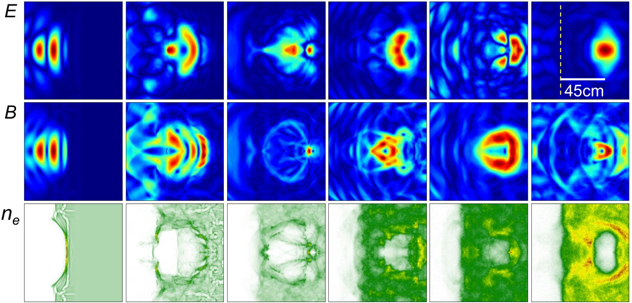Plasmas are gases of charged particles, with the behavior of the system dominated by long-range electromagnetic forces. Plasmas, as the “fourth state of matter”, are by far the most common phase of ordinary matter in the universe. Stars (including our Sun), interstellar and intergalactic space are all plasmas. Plasma physics is widely applied in understanding the glorious aurora and lightening on Earth, in material processing, in constructing compact “table-top” particle accelerators and in controlled fusion energy research. Faculties of Institute for Fusion Theory and Simulation (IFTS) are involved in the following areas of plasma physics: natural plasma in space and Earth atmosphere; theory, simulations and experimental study of magnetically confined fusion plasmas, advanced concept fusion reactor (stellarator) design; and high energy density physics including laser-particle acceleration. The research activities can be divided into three categories:
1. Magnetic Confinement Fusion (MCF) research uses magnetic field to confine plasmas for a sufficiently long time for the fuel deuterium and tritium ions to fuse, and generate neutrons and energetic alpha particles. The leading MCF facilities include tokamaks and stellarators. At IFTS, the research topics related to MCF include:
a) Large scale gyrokinetic/hybrid simulation and theoretical study of energetic (alpha-) particle physics, including symmetry breaking shear Alfven wave (SAW) fluctuations excitation, nonlinear saturation, SAW-induced anomalous energetic particle transport and fuel-ion heating (Liu Chen, Guoyong Fu, Zhiwei Ma, Zhengmao Sheng and Zhiyong Qiu)


b) Large scale gyrokinetic simulation of micro- drift wave turbulence driven by plasma temperature nonuniformities and related thermal plasma transport in tokamak plasmas (Yong Xiao)


c) Theoretical research on drift wave and drift Alfven wave turbulence, related transport, and nonlinear dynamics including zonal structure generation (Liu Chen and Zhiyong Qiu)
d) Experimental investigation of laboratory plasma physics including tokamaks and linear devices (Weiwen Xiao) and advanced concept stellarator design (Guoyong Fu)
e) Magnetohydrodynamic (MHD) and hybrid kinetic-MHD codes development and application to MCF studies (Zhiwei Ma)
f) New particle simulation scheme development, and application to both MCF and space plasma research (Liu Chen)
2. Space Plasma Physics studies the plasmas as they occur naturally in, e.g., Earth’s upper atmosphere, and the solar system. It covers a far-ranging number of topics including the solar physics of the Sun: the solar wind, planetary magnetosphere and ionosphere, auroras, cosmic rays, synchrotron, and so on. Space physics has important implications for understanding the universe, and for practical everyday life, including the operations of communications and weather satellites.
a) Large scale simulation and theoretical study of space plasma physics including aurora, sub-storms, solar flare, corona mass ejection, whistler chorus and magnetic connection (Zhiwei Ma, Liu Chen)

b) New theory of Ball-lightning (Hui-Chun Wu)

3. High Energy Density Physics (HEDP) focuses on extreme plasma state created by ultrashort intense laser or pulsed power sources. Its research scope includes inertial confinement fusion (ICF), laser plasma interaction, novel radiation and particle sources, and Z-pinch etc. Faculties of IFTS work on high energy density physics, laser-particle acceleration and fast-ignition in inertial confinement fusion (Zhengmao Sheng, Hui-Chun Wu).

Add: No. 8 Hainayuan Building, Zijingang Campus, Zhejiang University, 866 Yuhangtang Rd, Hangzhou, 310027, P.R. China
Tel: +86-571-87953325
Fax: +86-571-87951895
Email: yongyi@zju.edu.cn